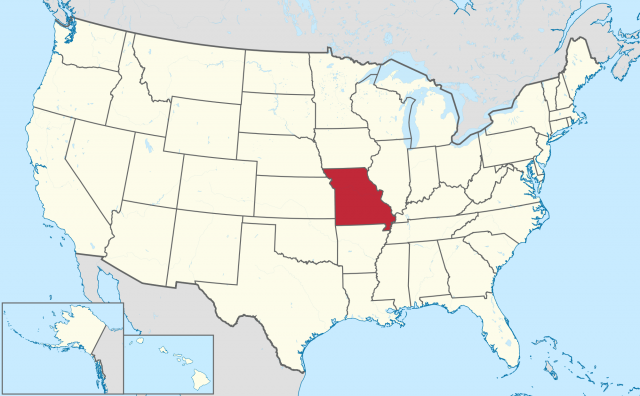Missouri
IN THE MIDWESTERN UNITED STATES, Missouri is the 19th state in terms of size of all the states. Its name is derived from a Native American word for “town of large canoes.” Missouri covers an area of 69,686 square mi (180,487 square km). A LANDLOCKED STATE, inland waters cover an area of 691 square mi (1,790 square km). The largest of these waters is Lake of the Ozarks in central Missouri. The state's north-south extent is 308 mi (496 km) and the east-west extent is 284 mi (457 km). With the MISSISSIPPI RIVER running along its eastern border, Missouri is bounded by eight states: IOWA, ILLINOIS, ARKANSAS, KANSAS, KENTUCKY, TENNESSEE, OKLAHOMA, and NEBRASKA.
Missouri, thanks in part to a lack of major physical features, has a continental climate with hot and humid summers coupled with cold winters. The average July temperature is 78 degrees F (26 degrees C), and the average January temperature is 31 degrees F (-1 degrees C). Missouri sees an average of 40 in (102 cm) of precipitation a year, the bulk of it falling in the south. The lack of features also creates space for contrasting air masses to meet, causing summer storms or tornadoes.

MISSOURI REGIONS
Missouri has several specific regions, all similar in their moist soil. In the north, the Dissected Till Plains run north of the Missouri River. This area is characterized by rolling hills and fertile plains with red soil. Very similar in the west are the Osage Plains, with slightly lower hills and less fertile soil. The Ozark Plateau covers most of the south. This is the largest physical area in Missouri and contains the state's highest point, Taum Sauk Mountain, at 1,722 ft (518 m).
In the southeast corner of the state are the lowlands, and the most fertile region, as the soil is nourished by the Mississippi River. The Mississippi has been both a blessing, in terms of navigation and agriculture, and a curse, as river flooding can be extensive and economically ruinous (the 1993 flood was particularly disastrous).
Missouri's forests, covering a little over a quarter of the state, are almost all located in the south. In the mid-southwest of the Ozark region are hickory and oak trees, while in the plains bald cypress and sweet gum are prevalent. Most of the wildflowers are found in the alluvial plains of the Mississippi, with milkweed, sweet William, mistletoe, and hawthorn widespread. Missouri is home to many common mammals, such as deer (the most prevalent), bears, rabbits, squirrels, minks, and muskrats. Common songbirds such as blue jays, cardinals, woodpeckers, and finches are all residents of Missouri, along with game birds like turkeys and quail.
Missouri was first explored by Native Americans, as much as 4,000 years ago, but was officially discovered by Jacques Marquette in 1673. Missouri, part of the LOUISIANA PURCHASE, became a U.S. territory in 1803, and a U.S. state 18 years later in 1821. Despite it being a slave state, Missouri was on the Union side during the Civil War. Though Jefferson City is the state capital, Missouri's St. Louis became the gateway to the west during the westward expansion and gold rush eras.